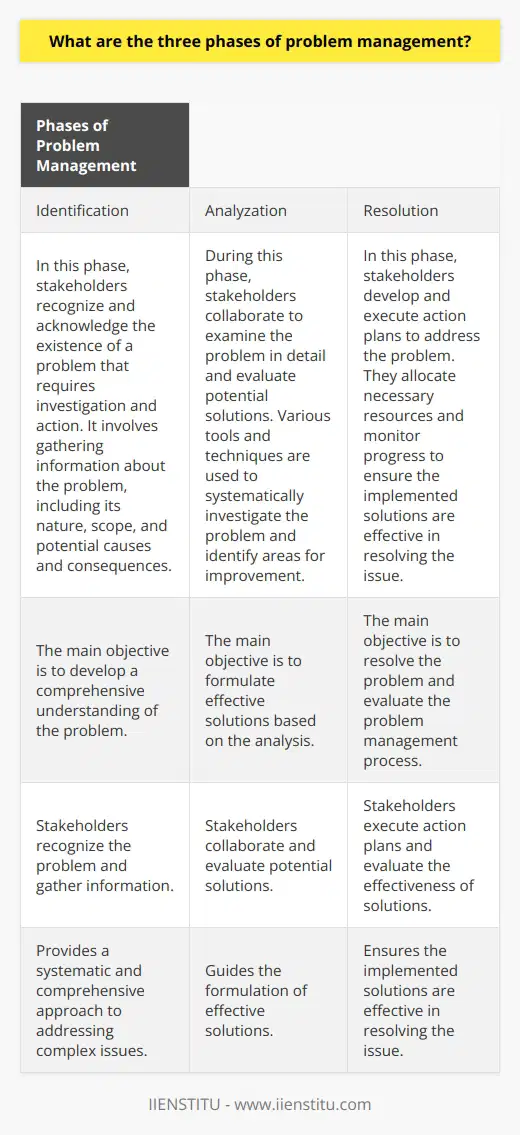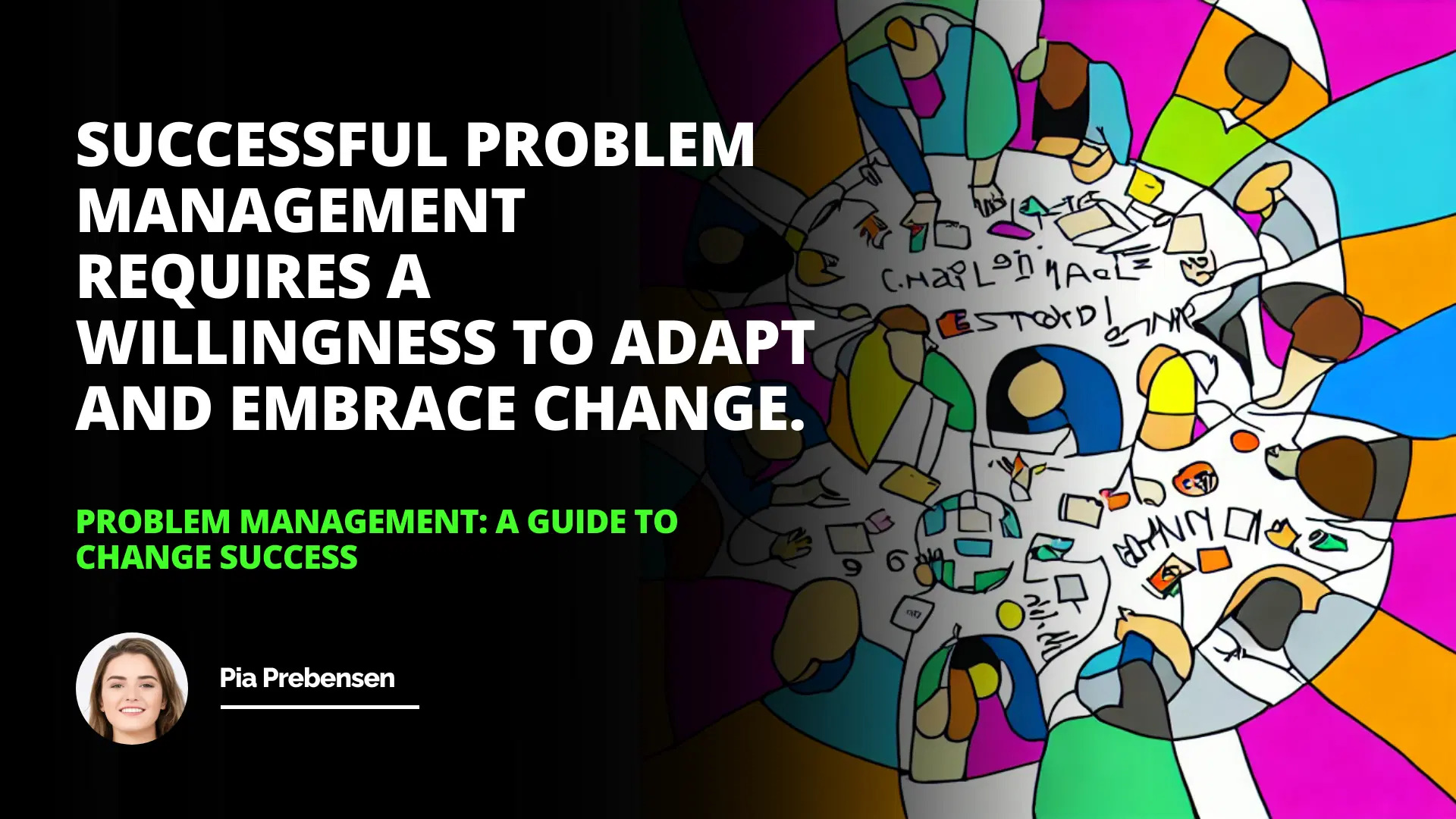
Introduction
Problem Management Processes
Benefits of Problem Management in Change Management
Challenges and Risks of Problem Management in Change Management
Conclusion
Change management is essential for any organization looking to stay competitive in today's rapidly changing world. It is essential to have a plan in place to ensure that any changes are implemented successfully, and problem management is a vital part of that plan.
Problem management helps organizations anticipate and address any problems that may arise during the change process. This blog post will provide an overview of problem management and its role in helping organizations effectively manage change.
Problem Management Processes
Problem management is identifying, analyzing, and solving problems that arise during the change process. It consists of several steps: problem identification, root cause analysis, problem resolution, and monitoring.
The first step in problem management is problem identification. This involves identifying any potential problems that may arise due to the change. This can be done through various methods, such as surveys, interviews, or focus groups.
Once potential problems have been identified, the next step is to conduct a root cause analysis. This involves analyzing the root cause of the problem and determining the most effective way to address it. This can be done through various methods, such as brainstorming, cause and effect diagrams, or the 5 Whys method.
The next step in problem management is problem resolution. This involves developing a plan to address the problem and determine the best way forward. This can include a variety of solutions, such as implementing new processes or training staff.
The final step in problem management is monitoring. This involves regularly monitoring the change's progress and the solution's impact. This can be done through various methods, such as surveys, interviews, or focus groups.
Risk Mitigation: An Essential Strategy for Successful Project Management
Lean Six Sigma: Optimal Strategies for Streamlined Process Efficiency
Benefits of Problem Management in Change Management
Problem management can benefit organizations looking to manage change more effectively. It can help organizations anticipate and address potential problems before they arise, which can help reduce the cost of implementing change. It can also help organizations identify underlying problems causing the change and address them more effectively.
Problem management can also help organizations develop more effective change plans. By understanding the root cause of the problem, organizations can develop better strategies to address it. This can help organizations develop more effective change plans better suited to their needs.
Challenges and Risks of Problem Management in Change Management
Although problem management can benefit organizations, it has several challenges and risks. One of the biggest challenges is accurately identifying potential problems before they occur. Organizations must ensure they have the right tools and techniques to identify potential problems.
Another challenge is determining the best way to address the problem. Finally, organizations must ensure they take the most effective approach to solving the problem. This can be a difficult task, as there are a variety of solutions to choose from.
Finally, organizations must know the potential risks of implementing problem management. This includes the risk of implementing ineffective solutions, as well as the risk of not addressing the root cause of the problem. Organizations must be aware of these risks and take steps to ensure they are appropriately managed.
Conclusion
Problem management is an integral part of any successful change management plan. It can provide organizations with various benefits, such as anticipating and addressing potential problems before they arise.
However, organizations must be aware of the challenges and risks associated with problem management to ensure it is implemented effectively. Organizations can ensure that their change management plans are successful by following the problem management process and taking the necessary steps to manage the risks.
Successful problem management requires a willingness to adapt and embrace change.

Frequently Asked Questions
What is problem management?
Problem management is a critical element of any successful organization. Organizations need to identify and address potential problems before they become serious issues. Problem management is a process that focuses on preventing, detecting, and resolving problems in order to ensure the smooth functioning of an organization.
The problem management process involves clearly defining the problem, assessing the extent of the problem and its impact on operations, determining possible causes and solutions, and implementing corrective action. This process helps organizations identify potential problems quickly, prioritize them based on severity, and develop practical solutions.
Organizations must also be aware of the potential risks associated with each problem. Risk assessment should be conducted before any corrective action is taken to ensure that any solution implemented does not cause further damage or create new risks for the organization. Once the risk assessment has been completed, organizations should evaluate various options for solving the issue before selecting a suitable course of action.
Problem management also involves monitoring progress throughout the resolution process to ensure that all goals are being met on time. During this phase, it is essential for organizations to provide regular updates on progress toward resolving the issue and any changes that need to be made during implementation. This will help ensure that all stakeholders remain informed throughout the resolution process.
In summary, problem management is essential to organizational success as it helps prevent and resolve issues quickly while minimizing disruption within operations. Therefore, organizations should establish clear policies and procedures related to problem management to handle any potential issues that arise within their operations effectively.
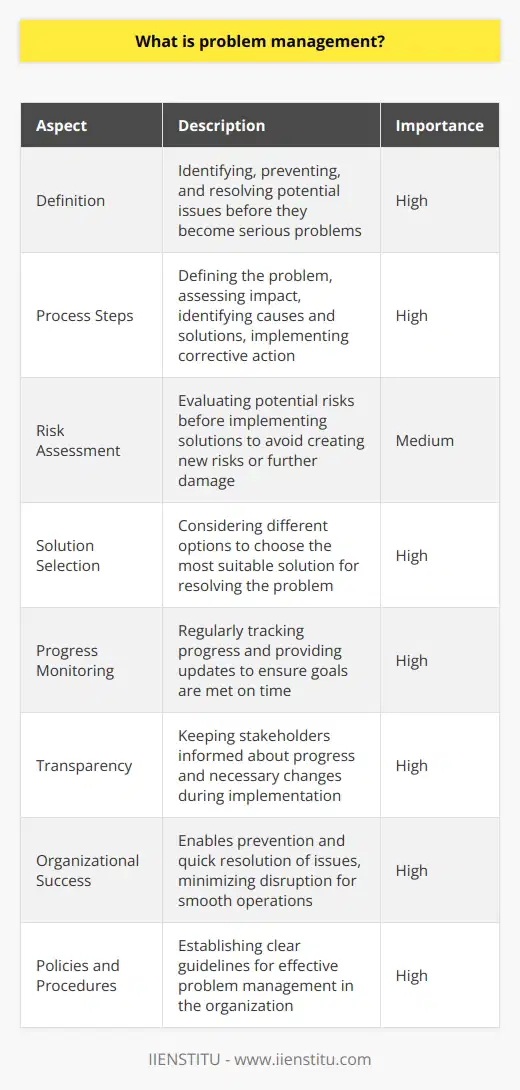
What are the steps involved in problem management?
Problem management is an integral part of many organizations’ IT operations. By identifying and solving problems before they become significant disruptions, organizations are better able to keep their systems running smoothly and efficiently. The steps involved in problem management involve identifying the issue, diagnosing the cause, proposing and implementing a resolution, and ensuring that the problem does not reoccur.
The first step in problem management is identifying the issue or potential issue. This is done by reviewing incident reports and monitoring any changes in system performance. Once the problem is identified, the next step is to diagnose the cause. This is often done by gathering environmental information and making an educated guess about the root cause. Once the cause is determined, the problem can be addressed.
The third step in problem management is to propose and implement a resolution. This typically involves developing a plan to fix the underlying problem and related issues. Next, the resolution should be tested and evaluated to ensure it effectively resolves the problem. Once the resolution is approved, it should be implemented and monitored to ensure it works as intended.
The final step in problem management is ensuring the problem does not reoccur. This is often done by documenting the resolution and testing it periodically to ensure it is still effective. Reviewing any environmental changes to ensure the problem does not resurface is also essential.
In conclusion, problem management is an essential part of IT operations. The steps involved in problem management include identifying the issue, diagnosing the cause, proposing and implementing a resolution, and ensuring the problem does not reoccur. By following these steps, organizations can better keep their systems running smoothly and efficiently.
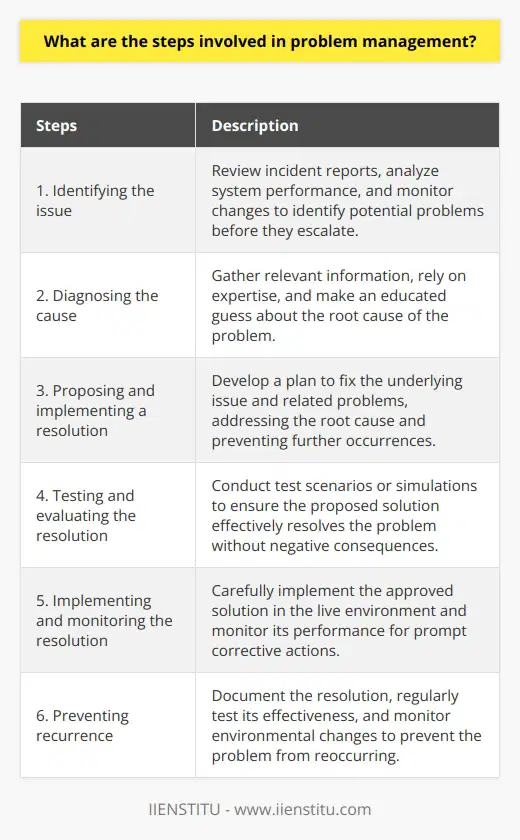
How can problem management help organizations manage change effectively?
Organizations are faced with the challenge of managing change daily. Organizations need to be able to manage change in order to remain competitive and remain successful effectively. Problem management can help organizations manage change effectively by proactively identifying and resolving issues before they become significant problems, minimizing the impact of changes, and using existing resources more efficiently.
Problem management is an integral part of any organization's approach to managing change. It involves identifying potential problems that may arise due to changes in the organization's operations or environment and taking proactive steps to prevent or mitigate them. A problem management plan should identify critical areas where issues may arise, such as technological changes, processes, personnel, or other aspects of the organization's operations. It should also provide strategies for addressing problems before they become major issues that could cause disruption or harm the organization's operations.
Effective problem management can help organizations minimize the impact of changes on their operations by preventing or mitigating potential problems before they occur. This can reduce downtime and disruptions caused by unexpected issues arising from changes in operations and limit financial losses associated with resolving those issues after they have occurred. In addition, by addressing potential problems before they become significant disruptions, organizations can also save time and resources that would otherwise be dedicated to resolving them after they have occurred.
Problem management can also help organizations use existing resources more efficiently by identifying areas where processes could be improved or streamlined through better utilization of technology or personnel resources. This enables organizations to make better use of their current resources while ensuring that any potential risks associated with new technologies are managed effectively. In addition, through effective problem management, organizations can ensure that their operational processes run smoothly and efficiently even when faced with significant changes in their environment or operations.
In conclusion, problem management is essential for helping organizations manage change effectively and minimize disruptions caused by unexpected events arising from changes in their environment or operations. By proactively identifying potential risks associated with organizational change before they occur and taking steps to prevent them from becoming significant issues, organizations can reduce downtime and financial losses associated with resolving those issues after they have occurred while using existing resources more efficiently in order to maintain operational efficiency even during periods of significant change.
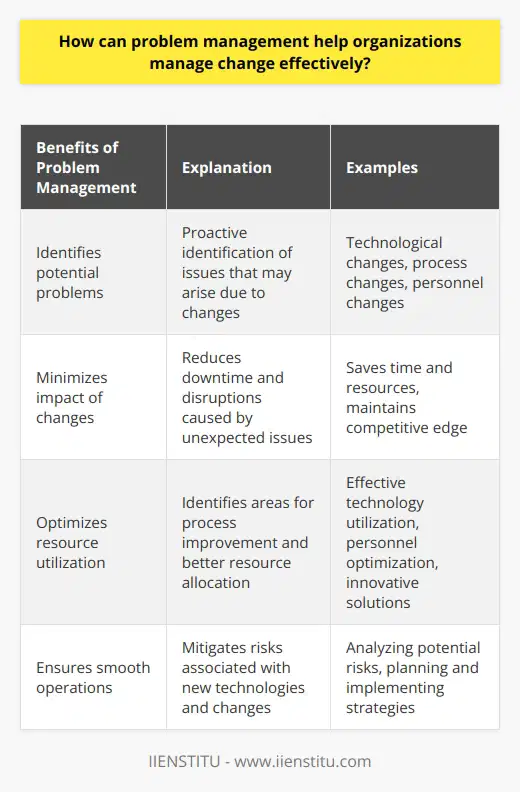
What is the main purpose of problem management?
Main Objective of Problem Management
The primary purpose of problem management is to identify, analyze, and resolve recurring incidents within an organization's IT infrastructure. This process aims to minimize the impact of these incidents on business operations, reduce their frequency, and prevent future occurrences to enhance overall system efficiency.
Identifying Root Causes
A critical component of problem management is the identification of root causes for recurring incidents. Through systematic analysis and examination of incident data, problem management teams can pinpoint the underlying factors that contribute to system issues. By addressing these root causes, organizations can effectively reduce incident frequency and prevent future issues from arising.
Reducing Negative Impact
Another key objective of problem management is to minimize the negative impact of incidents on a business's day-to-day operations. This is achieved by implementing effective corrective measures to resolve issues as quickly and efficiently as possible. In turn, this minimizes downtime, ensures the continuity of business processes, and optimizes resources.
Preventing Future Occurrences
In addition to resolving current incidents, problem management also aims to prevent future occurrences by proactively evaluating risks and implementing preventive measures. By identifying patterns, trends, and potential weaknesses in the IT infrastructure, problem management teams can develop strategies to mitigate risks and reduce the likelihood of recurrence. This approach helps organizations maintain a stable, reliable, and efficient IT environment.
Streamlining Communication
Problem management also serves to streamline communication between different teams and stakeholders within an organization. By establishing clear processes and guidelines for reporting, prioritizing, and addressing issues, problem management teams can foster a culture of transparency and accountability, ensuring seamless collaboration between teams to resolve incidents in a timely manner.
Enhancing System Efficiency
In conclusion, the main purpose of problem management is to enhance overall system efficiency by identifying and addressing root causes of recurring incidents, minimizing their negative impact on operations, and preventing future occurrences through proactive risk mitigation. By streamlining communication and fostering a culture of continuous improvement, problem management plays an integral role in supporting an organization's growth, stability, and success.
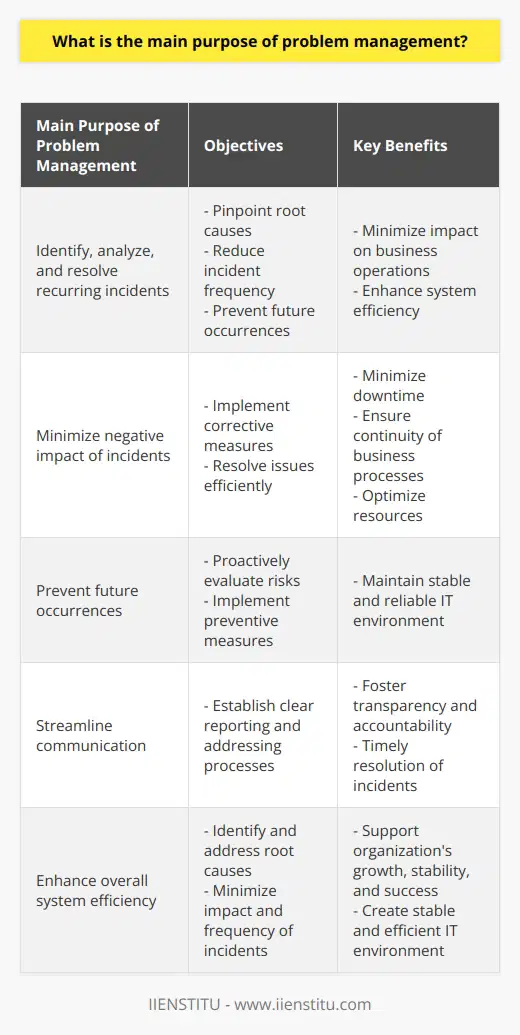
How does problem management work with change management?
Integration of Problem and Change Management
Problem management and change management are two essential components of IT service management, focusing on identifying, analyzing, and resolving problems, as well as planning and implementing changes, respectively. Their collaboration ensures that problem resolution and change implementation occur effectively and efficiently.
Relationship between Problem and Change Management
The relationship between problem management and change management is evident, as problem-solving efforts often lead to the discovery of underlying issues that require changes. Problem management, therefore, initiates the process of change management by identifying the root causes of problems and recommending appropriate changes to be made.
RFC and Change Evaluation
When a problem's root cause is identified, a Request for Change (RFC) is raised, formally proposing a change to resolve the issue. Change management then evaluates the RFC, considering its impact, urgency, and feasibility. This evaluation may involve consulting with relevant stakeholders, assessing the potential risks, and determining the required resources for implementation.
Coordination and Implementation of Changes
Once the change is approved, problem management and change management work together to coordinate and implement the change. Problem management ensures that the root cause is addressed, while change management focuses on preventing unintended consequences, guaranteeing minimal adverse effects on business processes, and maintaining service continuity.
Post-Implementation Review
After the change is successfully implemented, both problem and change management teams conduct a post-implementation review. This review aims to ensure that the change has resolved the original problem and not led to new issues. Additionally, the teams reflect on the effectiveness of their collaboration, identifying areas for potential improvement in future endeavors.
In conclusion, problem management and change management are complementary processes that work hand in hand to address and solve issues within an organization. Their collaborative efforts help ensure problem-solving efficiency and maintain desired service quality.
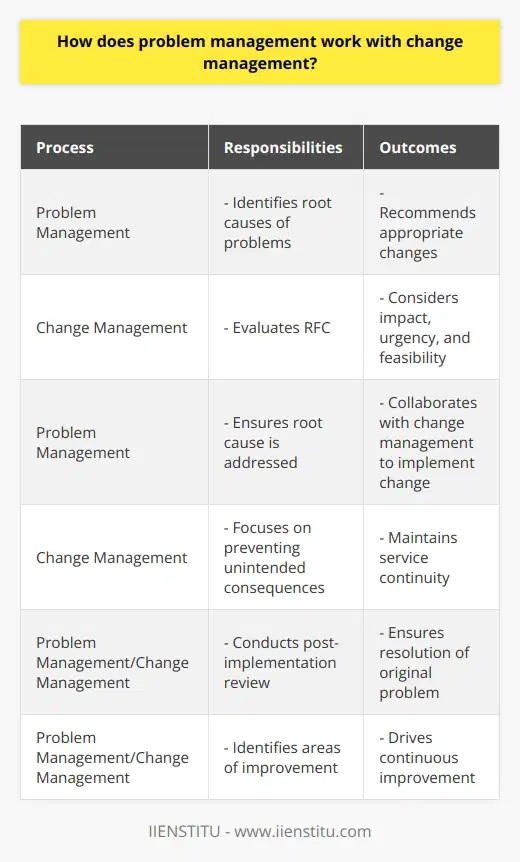
What are the three phases of problem management?
Identification Phase
The first phase of problem management involves identifying problems. This entails recognizing and acknowledging the existence of an issue or challenge that requires investigation and action. In this phase, stakeholders gather information about the nature and scope of the problem, as well as any potential causes and consequences. Problem identification is crucial in order to develop an understanding of the issue and to establish the foundation for subsequent phases of problem management.
Analysis Phase
Following identification, the analysis phase plays an essential role in problem management. In this stage, stakeholders collaboratively examine the problem, assess its impact, and evaluate potential solutions to address it. They may also employ various tools and techniques, such as root cause analysis, risk assessments, or performance metrics, to systematically investigate the problem's underlying causes and identify areas for improvement. The primary goal of the analysis phase is to generate a clear, comprehensive understanding of the problem, which will be instrumental in formulating effective solutions.
Resolution Phase
The final phase in problem management is the resolution phase, which focuses on implementing the chosen solutions to address the problem. In this phase, stakeholders develop and execute action plans, allocate resources, and monitor progress to ensure that the implemented solutions are effective in resolving the issue. Once the problem has been resolved, the resolution phase concludes with an evaluation of the entire problem management process, including lessons learned and opportunities for continuous improvement. This critical reflection allows for more efficient and effective problem management in the future.
In conclusion, problem management involves three distinct phases: identification, analysis, and resolution. Each phase serves a specific purpose in the overall process, ensuring a thorough and systematic approach to tackling complex issues. By following these phases, organizations can successfully manage problems, overcome challenges, and continually improve their performance.
